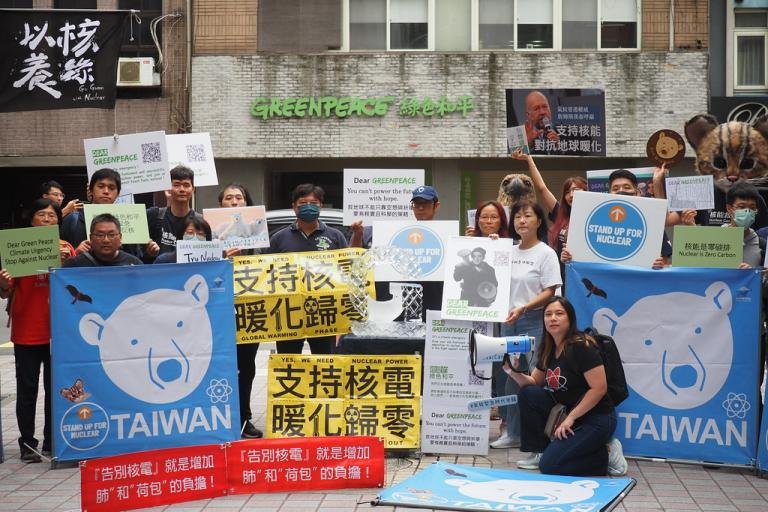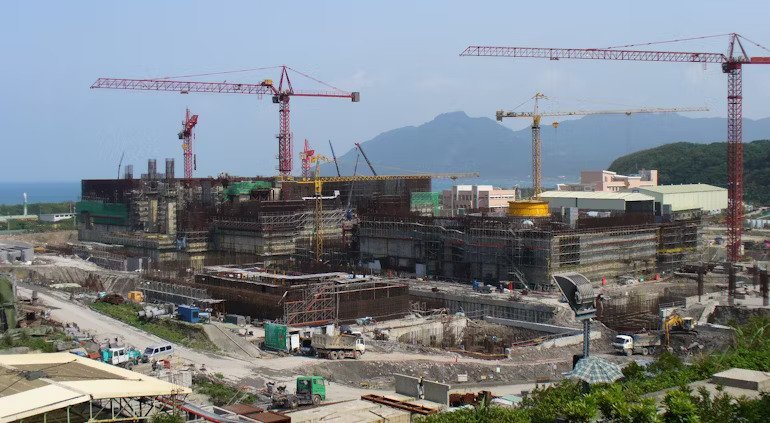Taiwan
17% of taiwan’s electricity comes from clean sources - 83% is dirty
taiwan has 1 nuclear plant remaining with two operating reactors
The Democratic progressive party (Dpp) rise to power in 2016, and plan a complete phaseout of the nuclear fleet
Jinshan unit 1, Taiwan’s oldest, closed in december 2018. unit 2 shut down in 2019 and Kousheng closed in 2021.
the closures so far took 3.2 gigawatts off the grid
Maanshan, the last remaining nuclear power plant in taiwan, provides 11% of the nation’s electricity
maanshan is key to Taiwan’s clean energy infrastructure, providing 56% of clean electricity
Nuclear phase-out dates: 2018-2025
What’s the current status?
The Democratic Progressive Party (DPP), elected in 2016, enshrined a “nuclear-free homeland” by 2025 in the Electricity Act and continues to confirm this phase-out as official policy.
Maanshan 1 was shut down on July 27, 2024. Maanshan 2 was shut down on May 17, 2025, the last of 6 reactors closed by the government.
Directly after Maanshan 2 was shut down, in May, 2025, a motion for a referendum to restart Maanshan passed Taiwan’s legislature. The referendum, backed by the KMT and TPP political parties, will take place on August 23, 2025, and decide if Maanshan 2 can continue operating.
Timeline of Closures
Jinshan 1 - Dec. 6, 2018.
Jinshan 2 - July 16, 2019.
Kuosheng 1 - July 1, 2021.
Kuosheng 2 - March 15, 2023.
Maanshan 1 - July 27, 2024.
Maanshan 2 - May 17, 2025.
why are they shutting down their nuclear plants and how did we get here?
(The key issues in Taiwan’s nuclear picture are opposition to authoritan government who like nuclear and with the accidents the already skeptical public empowered academics to challenge and influence elites of anti-nuclear rhetoric, anti-nuclear environmentalism, politics, and fear of nuclear energy.) will reword once the rest is done
In 1956, under Chiang Kai-shek's authoritarian regime leadership, Taiwan was eager to develop its nuclear expertise and secure the island's energy independence by exploring a research reactor at National Tsinghua University. The reactor was part of a broader effort to develop nuclear expertise and construction was completed in 1961. In the 1970’s, a nuclear program was established and construction on Taiwan’s first commercial nuclear plant, Jinshan, began in 1972 and was completed in 1978. By 1987, at the peak of Taiwan's nuclear, their reactors produced over 50% of the nation’s electricity.
However, during this time the skepticism of nuclear energy was simultaneously growing among the public, scientists, the communities near nuclear facilities, and the urban middle class that was satisfied in material needs and critical of unlimited growth. Nuclear development, deeply tied to Kai-shek's authoritarian agenda, became a symbol of his regime, ultimately representing the oppressive nature of his rule in the eyes of the public.
Views on nuclear energy evolved along partisan lines led by anti-nuclear scientists, like Edgar Lin, Chang Kuo-lung, and Huang Ti-Yuan sympathised with the democratic movement. Chang and Lin would go on to join the DPP, becoming involved in politics. DPP created anti-KMP sentiment through a variety of environmental issues, most importantly, nuclear. Environmental activists found “rising political elites in opposition willing to accept new ideas.”
With the news of Three Mile Island in 1979, academics were emboldened to speak out against nuclear, and between 1979 - 1986 197 articles critical of nuclear energy were published in Taiwanese magazines. Prominent biologist and National Tsinghua University professor, Edgar Lin, who would be coined the “godfather of the anti-nuclear movement,” wrote the first public essay criticizing the lack of safety of nuclear.
Seven years later in 1986, the Democratic Progressive Party (DPP), formed and adopted an anti-nuclear stance, opposing the Chiang Kai-shek’s pro-nuclear Kuomintang (KMT) party. As Ming-Sho Ho, a professor of sociology who studied anti-nuclear advocacy in Taiwan from 1980-2000 states, "the anti-nuclear cause was both a goal in itself and an instrument to challenge the KMT's authority.”
The DPP’s participation in the anti-nuclear movement only grew deeper starting in 1986. As they grew, they became a significant challenge to the ruling KMT regime. At this time Taiwan was undergoing a transition to democracy and opposing nuclear became a way for DPP to challenge the KMT’s authority. DPP’s original charter (their founding platform) pledged to not construct new plants and to increase surveillance over the current nuclear plants.
Anti-nuclear scholars formed the Taiwan Environmental Protection Union (TEPU) in 1987 and collaborated closely with the DPP to oppose nuclear among other political issues. In the 1980’s they organized large scale demonstrations against nuclear, including a large rally in Taipei against construction of the “fourth nuclear plant”. TEPU worked especially the New Tide faction of the DPP, and supported protests. TEPU and DPP sometimes shared office space and even workers.
Also in response to Chernobyl, Mothers Against Nuclear Power (MANP), formed in 1988 to oppose nuclear plants in Taiwan on health and public safety grounds.
TEPU held large scale anti-nuclear rallies in Taipei. Anti-nuclear speech from advocates and some scientists convinced many local fishermen to oppose nuclear. In 1988, the Yenliao Anti-Nuclear Self-Defense Association (SDA) formed and would fight nuclear for over a decade. In 1996, the Taiwanese Green Party (TGP) formed to try to wrest anti-nuclear ideology from the DPP. (Reword and join this section)
The Fukushima Daiichi disaster in 2011 instilled nuclear fear throughout Taiwan, particularly because the island nation is similarly prone natural disasters like earthquakes and typhoons. The DPP capitalized in the years that followed, entering office and driving the nuclear shut down campaign.
Anti-nuclear groups formed as a result of the Fukushima accident, including the National Nuclear Abolition Action Platform and Mom Loves Taiwan.
Despite a 2018 referendum where nearly 60% of voters rejected closing all reactors by 2025, the DPP continued its phase-out policy. A second referendum, in 2021, however, asking voters whether they supported restarting construction of the Fourth Nuclear Plant (Lungmen), was rejected. Only 41% of voters participated.
Public opinion on nuclear has become more favorable in recent years. With increasing energy concerns and grid issues, there has been pushback against the phase-out and efforts to save the final reactor, Maanshan 2. Conflict with China and blackouts have led for more calls to extend the life of Maanshan.
With energy supply and price concerns, Taiwanese industrial companies have called for a return to nuclear. Pegatron Corporation (a large electronics manufacturing company) chairman T.H. Tung has called for a reversal of the phase out in 2023, for purposes of the island’s growing energy needs as well as decarbonization efforts.
The government, in a shift of position, has voiced support for nuclear energy as well. Premier Jung-tai Cho said Taiwan wants to keep pace with international countries by adopting new nuclear technologies.
what can you do to help?
effects of the 5 (and possibly 6) reactor closures
“If Taiwan phases out its nuclear by 2025, electricity prices will increase by at least 10 percent assuming that fuel prices remain steady.” - Environmental Progress
“And it comes with the island’s power supplies already stretched, threatening economic growth. Taiwan has raised electricity prices twice this year, with the latest being a 12.5% increase for industrial users that began earlier this month.” - Bloomberg 10/21/2024.
In an island that imports the vast majority of its energy, a blockade from China poses serious risk to Taiwan’s vitality and independence. Taiwan only has 10 days worth of natural gas supplies, currently. (Bloomberg) Things may get worse as consumption is only expected to increase as much as 13% by 2030.
Hsinchu, Taiwan is home to Taiwan’s high tech and power hungry industry, and particularly the semiconductor industry. In 2021, Taiwan Semiconductor Manufacturing Company (TSMC) alone used 6.4% of Taiwan’s grid, and Bloomberg predicts this figure to rise to as much as 12.5% by 2025. Without secure, reliable power, Taiwan will face serious economic consequences.
Maanshan Nuclear Plant. Maanshan Unit 2 is Taiwan’s sole remaining nuclear reactor. Conflict with China and blackouts on the island have led to calls for a 20 year life extension.
Construction on Lungmen Nuclear Plant, two 1350 MW reactors that never entered commercial operation because of anti-nuclear opposition.
All together Taiwan’s nuclear closures took 3.2 gigawatts of the grid. The planned nuclear phase out in Taiwan is particularly fraught considering the island imports 97% of its energy from maritime shipping routes.
In the 1980’s, Taiwan received roughly half their electricity from nuclear energy, with 6 working reactors. If it were not for strong a anti-nuclear presence, Lungmen could have brought an additional two 1,350 MW reactors online, ensuring energy security, and making Taiwan a true climate leader. Instead they spent billions to mothball one reactor and scrap another mid-build.
pro-nuclear advocacy movement & our efforts
2017 - On Monday, October 23, 2017, pro-nuclear NGO Environmental Progress and leading global environmental scientists and energy experts sent an open letter (致蔡英文總統公開信中文翻譯) to Taiwanese President Tsai Ing-wen urging her to reconsider that nation's nuclear phase-out.
2020 - On September 12, our allies held a Stand Up for Nuclear Taiwan event using umbrellas designed with polar bears to raise climate awareness. Activists held signs and delivered speeches.
2021 - Activists post photos of themselves on social media standing on one foot before the December 18th referendum to signal that renewable energy alone is not enough to decarbonize on a steady footing and nuclear is needed.
2024 - Advocates pressure KMT legislators to stand up for nuclear.






